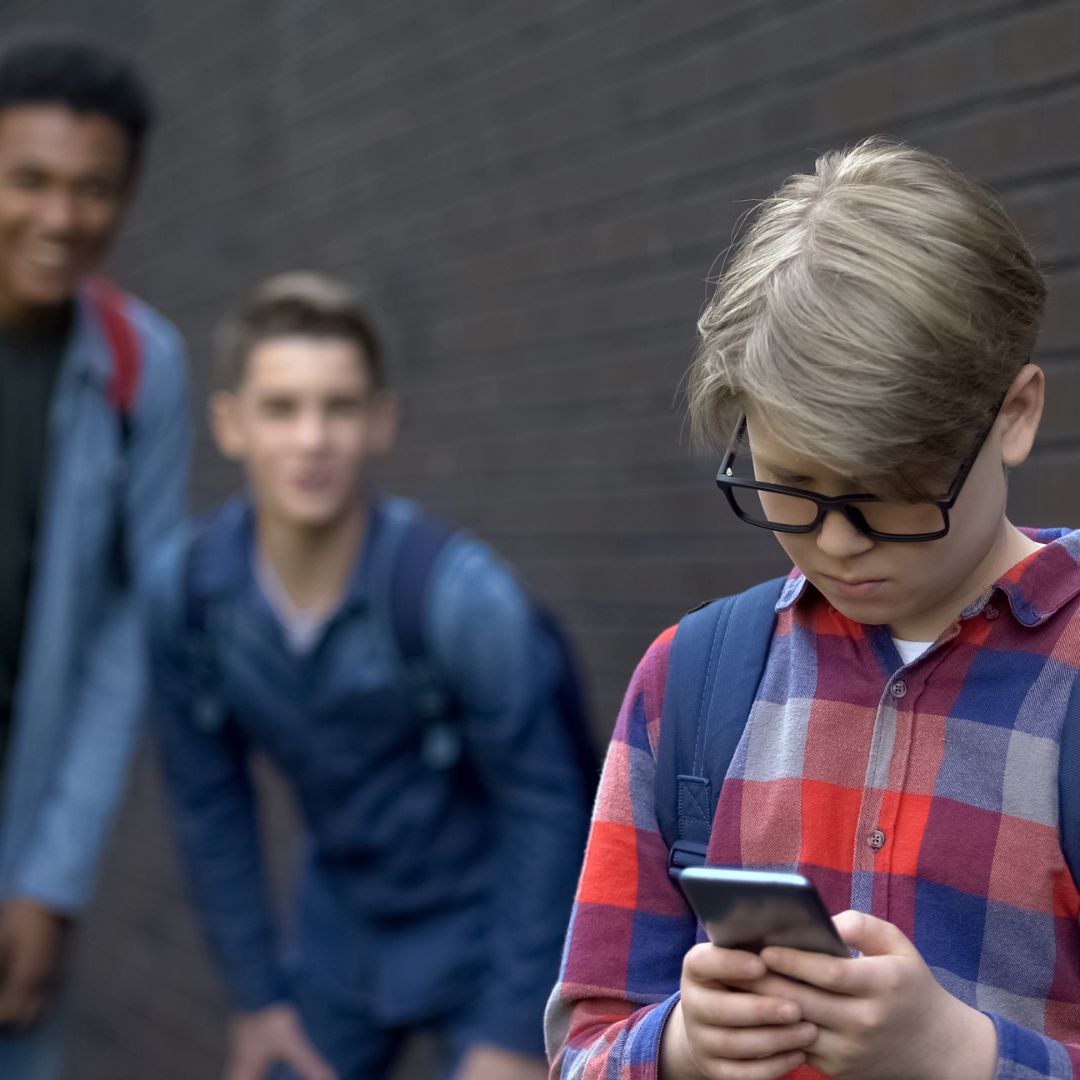Published: 4.5.22
Updated: 24.7.24
Cyberbullying is a relatively new form of bullying that has been getting more attention as it becomes increasingly common.
In 2020, approx. 19% of children aged between 10-15 reported being victims of cyberbullying in the UK (That's one in five children).
Cyberbullying can take many forms including posting mean or embarrassing photos online, spreading rumors through social media sites like Facebook and Twitter, or sending threatening text messages or emails with attachments such as viruses.
The effects of these actions can be devastating for victims since they are often embarrassed by their peers and have no way to stop the harassment from happening again.
This can lead to depression, anxiety, and in some cases, suicide attempts and completion.
Causes of Cyberbullying:
The exact cause of cyberbullying is unknown but many think that the anonymity and permanence of the internet has played a large part in its spread.
People tend to feel more protected when they are online so they may be more likely to say things they wouldn't normally say if there were no repercussions, and the permanence and searchability of information online can make it difficult to remove anything offensive that is posted.
Some causes include:
- Lack of parental supervision over children's Internet use or their computer activities (Nunes & Nowell, 2013) (Balfe & Li, 2004);
- Lack of experience with the Internet and/or computers;
- Racial, ethnic, or religious differences between the offender and victim;
- Low self-esteem in both victims and bullies;
- Lack of knowledge about appropriate online behavior. (Nunes & Nowell, 2013)
- Bullying is not directly caused by any one factor but rather a variety of risk factors coming together to increase the likelihood of bullying.
- There are many potential risk factors that may contribute to children becoming bullies or victims.
- Bullies are more likely to have friends who bully, be male, and have low grades in school (Nunes & Nowell, 2013). Victims tend to come from families characterised by dysfunction
- Low self-esteem is also a risk factor for both bullies and victims.
Effects of Cyberbullying:
The effects of cyberbullying are similar to those experienced in physical bullying since they include depression, anxiety, loneliness, low self-confidence, poor academic performance, and in some cases, even suicide.
The effects can be more severe for younger children who may not realise that the information posted online is permanent and doesn't go away with time.
They may also be less likely to find ways to stop cyberbullying because it is done through technology which they may feel is out of their control.
When cyberbullying involves the distribution of embarrassing or threatening photos, information about victims spreads to a much larger audience than physical bullying, making it potentially more devastating.
In some cases, the harassment may never stop especially if young people aren't educated on how to seek help and avoid becoming victims.
A study by Craig and Pepler (1997) found that 27% of children who were bullied online reported bullying incidents happening more than once, while only 8% who were bullied in person said it happened more than once.
This suggests that cyberbullying can have a much longer lasting effect on its victims especially if it continues over a long period of time.
Remedies:
Preventing cyberbullying requires a comprehensive approach that includes education, parental involvement, and legal measures.
-
Education and Awareness:
- Teaching Responsible Internet Use: Young people need to learn how to use computers and the internet responsibly. This includes understanding what information should and shouldn't be shared, recognising and reporting online bullying, and avoiding "headless" communication (using webcams or microphones without showing their face).
- Early Education on Social Media Practices: Teaching safe social media practices at an early age can significantly reduce the likelihood of children engaging in cyberbullying. Schools and educators should create programs to educate students about appropriate online behavior.
- Community and Organisational Programs: Organisations like stopbullying.gov and kidsecure.com have developed educational programs and awareness campaigns to prevent cyberbullying. These initiatives aim to increase awareness and provide resources for both victims and educators.
-
Parental Involvement:
- Monitoring and Restrictions: Parents can play a crucial role in preventing cyberbullying by setting up restrictions on the amount of time their child is allowed to be on the internet, checking the websites they visit, and monitoring text messages sent from phones.
- Open Communication: Encouraging open communication between parents and children about their online experiences can help identify and address issues before they escalate.
-
Legal Implications and Actions:
- Understanding Legal Consequences: Both parents and children should be made aware of the legal consequences of cyberbullying. Many countries have laws in place that can result in severe penalties for cyberbullying, including fines and imprisonment.
- Reporting Cyberbullying: Victims of cyberbullying should be encouraged to report incidents to the relevant authorities. This can include reporting to school officials, local law enforcement, or online platforms where the bullying is occurring.
- Protective Orders: In severe cases, victims can seek protective orders against their bullies. These legal measures can help prevent further contact and harassment.
-
Role of Schools and Educators:
- Implementing Educational Programs: Schools should implement comprehensive programs that teach students about the consequences of cyberbullying and appropriate online behavior.
- Creating Support Systems: Establishing support systems within schools can provide victims with the necessary help and resources to cope with cyberbullying.
-
Awareness Campaigns:
- Community Involvement: Awareness campaigns can help to raise public awareness about cyberbullying and its prevention. Community programs can also play a role in educating the public and providing support to victims.
By combining education, parental involvement, legal measures, and community awareness, the negative effects of cyberbullying can be mitigated.
These strategies not only help prevent cyberbullying but also aid in developing responsible digital citizens who can navigate the online world safely and respectfully.
Causes of Cyberbullying
Cyberbullying, a modern form of harassment that occurs through digital platforms, has become increasingly prevalent with the rise of social media and internet usage. Understanding the causes of cyberbullying is crucial to developing effective prevention and intervention strategies.
Key Causes
-
Anonymity and Lack of Accountability
- The internet allows individuals to hide behind anonymous profiles, making them feel emboldened to say things they wouldn't in person due to the perceived lack of consequences. This anonymity can lead to more aggressive and harmful behavior online.
-
Lack of Parental Supervision
- Many instances of cyberbullying occur without the knowledge of parents or guardians. When children and teens use the internet without supervision, they may engage in or become victims of cyberbullying.
-
Social and Peer Influence
- Peer pressure and the desire to fit in can drive individuals to bully others online. Bullies often have friends who also engage in bullying, creating a culture where such behavior is normalised and even encouraged.
-
Low Self-Esteem
- Both bullies and victims of cyberbullying often struggle with low self-esteem. Bullies may project their insecurities onto others to feel more powerful, while victims may be targeted because they are perceived as vulnerable.
-
Lack of Awareness and Education
- Many young people are not adequately educated about appropriate online behavior and the potential consequences of cyberbullying. This lack of knowledge can lead to unintentional harm or escalation of conflicts.
Specific Examples and Case Studies
Megan's Story
Megan was a victim of both physical and cyberbullying, which led to severe emotional distress, including self-harm and anxiety. Her situation worsened after a boy she trusted pressured her into sending a naked photo, which was subsequently shared widely, resulting in relentless bullying.
Carney Bonner's Experience
Carney, at 14, received a Facebook message telling him he "shouldn't exist." The cyberbullying continued for a year, severely impacting his mental health and leading him to self-harm. It was only after a friend noticed his injuries and intervened that he received the help he needed. Carney later became a 'cyber mentor' to help others facing similar issues.
Amanda Todd
Amanda Todd's case is one of the most well-known instances of cyberbullying. At the age of 15, she was coerced into flashing her breasts on a webcam. The image was later used to blackmail her, and despite changing schools, she couldn't escape the harassment. The relentless bullying led her to take her own life, but not before she posted a video detailing her ordeal.
Conclusion
Cyberbullying is a multifaceted issue with various causes, including anonymity, lack of supervision, social influences, low self-esteem, and inadequate education about online behavior. The devastating effects on victims, as illustrated by the cases of Megan, Carney, and Amanda, highlight the urgent need for comprehensive strategies to combat this form of bullying. These strategies should involve education, parental involvement, and robust support systems for victims.
Role of Social Media Platforms in Combating Cyberbullying
Social media platforms like Facebook and Twitter have implemented various measures to combat cyberbullying, aiming to create safer online environments for their users. Here's an overview of the strategies and actions taken by these platforms:
Facebook's Approach
Facebook has developed comprehensive policies and tools to address bullying and harassment on its platform:
-
Community Standards
- Facebook's Community Standards explicitly prohibit bullying and harassment, including threats, malicious contact, and the release of personally identifiable information. The platform distinguishes between public figures and private individuals, offering greater protections for the latter.
-
Reporting and Enforcement
- Users can report content that violates these standards. Facebook's moderators review reports and take appropriate actions, which may include removing content, issuing warnings, or temporarily blocking users from certain features. Persistent offenders may have their accounts permanently removed.
-
Automated Tools and Human Review
- Facebook uses automated tools to detect abusive behavior, although it acknowledges that human review is often necessary for more complex cases. The platform's biannual Community Standards Enforcement Report provides transparency on the actions taken against violating content.
-
Bullying Prevention Hub
- Facebook offers a Bullying Prevention Hub, which provides resources and guidance for teens, parents, and educators on how to address and prevent bullying.
Twitter's (now X) Approach
Twitter has also implemented several measures to combat cyberbullying:
-
Hateful Conduct Policy
- Twitter's Hateful Conduct Policy prohibits behavior that harasses, intimidates, or uses fear to silence another user's voice. This includes abusive tweets, direct messages, and targeted harassment.
-
Reporting Mechanisms
- Users can report abusive behavior directly through the platform. Twitter's safety team reviews these reports and takes action, which may include removing tweets, temporarily locking accounts, or permanently suspending users.
-
Safety Tools
- Twitter provides tools such as the ability to mute or block users, filter notifications, and control who can reply to tweets. These features empower users to manage their interactions and reduce exposure to harmful content.
-
Transparency Reports
- Twitter publishes transparency reports that detail the platform's efforts to enforce its policies, including the number of accounts actioned and the types of violations addressed.
Effectiveness and Challenges
Despite these measures, social media platforms face several challenges in effectively combating cyberbullying:
-
Detection and Reporting
- Automated tools can struggle to accurately detect nuanced cases of bullying and harassment, often requiring human intervention. However, the volume of content makes comprehensive human review challenging.
-
User Engagement
- Encouraging users to report abusive content and use available safety tools is critical. Platforms must balance user privacy with the need for effective moderation.
-
Legal and Cultural Differences
- Social media companies must navigate varying legal requirements and cultural norms across different regions, complicating the enforcement of uniform policies.
-
Transparency and Accountability
- Platforms are often criticised for a lack of transparency in their moderation processes and the perceived inconsistency in policy enforcement. Addressing these concerns is essential for building user trust.
Educational and Preventive Measures
In addition to policy enforcement, education and awareness are crucial in preventing cyberbullying:
-
Educational Programs
- Schools and organisations should implement programs that teach students about responsible internet use and the consequences of cyberbullying.
-
Parental Involvement
- Parents can help prevent cyberbullying by monitoring their children's online activities, setting time restrictions, and discussing safe internet practices.
-
Community Initiatives
- Awareness campaigns and community programs can raise awareness about the impact of cyberbullying and promote positive online behavior.
For more detailed information, you can visit the following resources:
- Facebook's Bullying and Harassment Policies
- Twitter's Hateful Conduct Policy
- PACER's National Bullying Prevention Center
- Facebook Safety Guide
Resources for Victims of Cyberbullying
| Organisation | Description | Services | Website | Phone |
|---|---|---|---|---|
| Cybersmile Foundation | A multi-award-winning anti-cyberbullying non-profit organisation. |
|
cybersmile.org | N/A |
| NSPCC and Childline | Offers support and advice for children dealing with bullying and cyberbullying. |
|
nspcc.org.uk | 0800 1111 |
| StopBullying.gov | Provides comprehensive resources for preventing and addressing bullying. |
|
stopbullying.gov | N/A |
| Cyberbullying Research Center | Provides information and resources to help deal with cyberbullying. |
|
cyberbullying.org | N/A |
| STOMP Out Bullying | Dedicated to reducing and preventing bullying through education and awareness. |
|
stompoutbullying.org | N/A |
| DoSomething.org | A youth-led movement for good that includes resources for stopping cyberbullying. |
|
dosomething.org | N/A |
| Parents Protect | Offers resources and advice for parents to help protect their children from cyberbullying. |
|
parentsprotect.co.uk | N/A |
| Anti-Bullying Alliance | A coalition of organisations and individuals working together to stop bullying. |
|
anti-bullyingalliance.org.uk | N/A |
Wrapping up:
Cyberbullying is a problem that affects many people, but it can be prevented through education and awareness.
If you or someone in your family has been the victim of cyberbullying before, make sure to educate yourself on how this form of bullying works so you know what to do if it happens again.
There are now more resources available online than ever before for victims with advice on everything from prevention techniques to coping mechanisms when things get tough.
The hope is that cyberbullies will become less common as they learn about appropriate internet behavior in school programs, at home discussions, and by visiting websites like these where they may find help along the way (Nunes & Nowell).
The definition of cyberbullying is the use of electronic communication to bully a person.
This can include text messages, emails, social media posts, and more. Cyberbullying can be just as harmful as traditional bullying.
Cyberbullying can have a number of negative effects on victims, including depression, anxiety, low self-esteem, and even suicide.
There are a few things that we can do to help prevent cyberbullying and mitigate its effects: talking to our kids about cyberbullying, reporting incidents when they occur, and creating safe online spaces for our children.
We need to work together to create a culture where cyberbullying is not tolerated - let’s start by talking to our kids about what is and isn’t okay online...
We can all make a difference.





Share:
Does Not Having A Father Affect A Child?